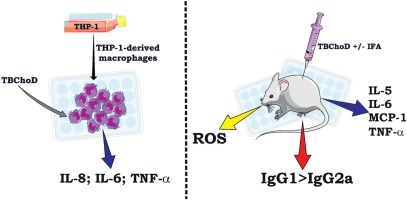
Bottom
The current limitations of conventional BCG vaccines highlight the importance in the development of new and effective vaccines against tuberculosis (TB). The use of probiotics such as Lactobacillus plantarum for the delivery of TB antigens through trans surface display provides an effective and safe vaccine approach against TB. Such a non-recombinant probiotic surface presentation strategy involves the fusion of candidate proteins with a cell wall-binding domain such as LysM, which allows the fusion protein to externally anchor to the L. plantarum cell wall, without the need for genetic modification of the vector.
This approach requires sufficient production of these recombinant fusion proteins in cell factories such as Escherichia coli, which has proven effective in producing heterologous proteins for decades. However, overexpression in the E. coli expression system resulted in a limited amount of soluble heterologous TB-LysM fusion protein, as most of it accumulates as insoluble aggregates in inclusion bodies (IBs). Conventional denaturation and renaturation methods for solubilizing BIs are expensive, time consuming, and tedious. Therefore, in this study, an alternative method for the solubilization of the Mycobacterium tuberculosis (TB) Recombinant antigen LysM protein from IB based on the use of the nondenaturing reagent N-lauroylsarcosine (NLS) was investigated.

Purity: greater than 90% as determined by SDS-PAGE.
Destination names: fbpA
Uniprot No.: P9WQP2
Reasearch Area: Others
Alternative Names
fbpA; mpt44; MT3911 Diacylglycerol acyltransferase/mycolyltransferase Ag85A; DGAT; EC 2.3.1.122; EC 2.3.1.20; Acyl-CoA:diacylglycerol acyltransferase; antigen 85 complex A; 85A; Ag85A; fibronectin-binding protein A; Fbps A
Mycobacterium tuberculosis species (CDC 1551/Oshkosh strain)
Source: E.coli
Expression Region: 53-331aa
Mole Weight: 34.1 kDa
Protein length: Partial
Tag Information: N-terminal 6xHis-tagged
Form: Liquid or Lyophilized Powder
Note: We will preferably ship the format we have in stock, however, if you have any special requirements for the format, please remark your requirement when placing the order, we will prepare according to your demand.
Buffer
If the dosage form is liquid, the default storage buffer is Tris/PBS based buffer, 5%-50% glycerol.
Note:
If you have any special requirement for glycerol content, please remark it when you order. If the administration form is lyophilized powder, the buffer before lyophilization is a Tris/PBS-based buffer, 6% trehalose, pH 8.0.
Reconstitution
We recommend that this vial be briefly centrifuged before opening to bring the contents to the bottom. Reconstitute protein in sterile deionized water at a concentration of 0.1-1.0 mg/mL. We recommend adding 5-50% glycerol (final concentration) and an aliquot for long-term storage at -20°C/-80°C. Our final default glycerol concentration is 50%. Customers could use it for reference.

Storage Conditions
Store at -20°C/-80°C upon receipt, need to be aliquoted for multiple use. Avoid repeated cycles of freezing and thawing.
Shelf life
Shelf life is related to many factors, storage condition, buffer ingredients, storage temperature and the stability of the protein itself. Generally, the shelf life of the liquid form is 6 months at -20°C/-80°C. The shelf life of the lyophilized form is 12 months at -20°C/-80°C.
Delivery time
3-7 business days
Notes: Repeated freezing and thawing is not recommended. Store working aliquots at 4°C for up to one week.
Results
Expression of the TB antigen-LysM fusion genes was carried out in Escherichia coli, but this resulted in IB deposition in contrast to expression of TB antigens alone. This suggested that the LysM fusion significantly altered the solubility of TB antigens produced in E. coli. The nondenaturing NLS technique was used and optimized to successfully solubilize and purify ~ 55% of cell wall-anchoring recombinant TB antigen from IBs. The functionality of the recovered protein was analyzed by immunofluorescence microscopy and whole cell ELISA which showed successful and stable cell wall attachment to L. plantarum (up to 5 days).
Conclusion
The presented NLS purification strategy enables an efficient and rapid method to obtain higher yields of soluble cell wall-anchored Mycobacterium tuberculosis antigens-IB LysM fusion proteins in E. coli.
